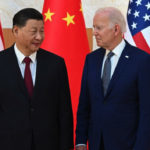
(WASHINGTON) — China continues to rapidly build its stockpile of nuclear warheads, according to the Pentagon’s latest annual report on China’s military that now estimates China could have as many as 1,500 warheads by 2035.
The U.S. is also concerned by what a senior defense official described as China’s establishment of “a new normal” of heightened military activity around the island following House Speaker Nancy Pelosi’s visit to Taiwan in August.
Formally known as the “Military and Security Developments Involving the People’s Republic of China,” the congressionally mandated annual report reaffirms the National Defense Strategy’s assessment that China “presents the most consequential and systemic challenge to U.S. national security and the free and open international system.”
“Based on the trend lines in the report, I think we can judge that the PRC (People’s Republic of China) has increasingly turned to the PLA (People’s Liberation Army) as kind of one of the key instruments of statecraft that it wants to use to pursue its interests,” a senior defense official told reporters about the report. “And that has serious implications for U.S. security interests, our allies and partners’ interests, and for the international rules-based order more broadly.”
Last year’s Pentagon report highlighted that China had set in motion a four-fold increase of its nuclear weapons arsenal and projected that it could have 700 warheads by 2027 and possibly 1,000 by 2030.
The new report released on Tuesday describes China as now having more than 400 nuclear warheads and continuing with the accelerated build-up of its arsenal, projecting that it could have 1,500 warheads by 2035. Even with China’s dramatic increase, it’s larger nuclear arsenal will still be much less than the United States’ declared stockpile of 3,750 warheads capable of being deployed by hundreds of land-based and sea-launched missiles and a strategic bomber fleet.
China has publicly set 2027 as a target date for its military to have the capabilities for the People’s Liberation Army to be “a more credible military tool for the Communist Party (CCP) to wield as it pursues Taiwan unification.”
The year 2035 is targeted for the completion of the PLA’s modernization and 2049 as the year that China’s military becomes a global force.
Earlier this month, Joint Chiefs Chairman Gen. Mark Milley stressed that, regardless of China’s publicly stated goal, the United States will not fall behind China militarily.
“China is not going to be a better military than the United States military is, but they’re going to try but they’re not going to get there,” Milley said at a Pentagon news conference. “The United States military is number one now, and we are going to be number one five years from now — 2027 is not going to be the date that China becomes number one. And we’re going to stay number one the entire time. And as long as we remain number one, then we will deter the war that people worry about, a great power war between China and the United States.”
The report also noted China’s heightened military activity around Taiwan over the last two years as it “increased provocative and destabilizing actions in and around the Taiwan Strait, to include increased flights into Taiwan’s self-declared Air Defense Identification Zone (ADIZ) and conducting island seizure exercises.”
Those activities peaked in August when China also conducted missile launches and naval operations during Pelosi’s visit to the island that China considers to be a breakaway province.
While the military activity around Taiwan has lessened in intensity, it remains higher than it had been before it appears that it has become “a new normal,” according to the senior defense official.
“That gives us a concern, even though we don’t see an imminent invasion, obviously, about sort of an elevated level of intimidating and coercive activity around Taiwan,” said the official.
“We see the PLA doing things like the increased crossings over the center line, and behavior that appears to be intended to kind of intimidate or sort of wear down Taiwan,” said the official. “Which, obviously, is just not what we want to see.”
The report released Tuesday comes two weeks after President Joe Biden met with China’s President Xi Jinping in Indonesia a week after Defense Secretary Lloyd Austin met with Gen. Wei Fenghe, China’s top military official, in Cambodia.
In his meeting with Wei, Austin was said to have “raised concerns about the increasingly dangerous behavior demonstrated by PLA aircraft in the Indo-Pacific region,” according to a Pentagon readout of the meeting.
The senior defense official said that Chinese military ships and aircraft “have exhibited an increase in unsafe and unprofessional behavior in the Indo-Pacific region” and highlighted aerobatic maneuvers and the discharge of chaff “that could make it dangerous for nearby aircraft to maneuver safely.”
Copyright © 2022, ABC Audio. All rights reserved.
